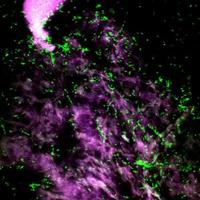
Microscopic fluorescent green Campylobacter cells on chicken skin. (Photo by Anna Bates)Reducing the pathogenic bacterium Campylobacter on poultry farms and in processing plants begins with finding its sources, one of which is the birds' lungs, Agricultural Research Service (ARS) scientists report.
Microbiologists Mark Berrang and Richard Meinersmann and animal physiologist Richard J. Buhr at the ARS Richard B. Russell Agricultural Research Center in Athens, Ga., studied Campylobacter before and after chicken carcasses were scalded to remove feathers, an integral step in poultry processing.
Bacteria can contaminate live chickens during production or transport, or carcasses during scalding. In either case, Campylobacter would contaminate respiratory air sacs and could then contaminate the abdominal cavity.
In a commercial processing plant, researchers collected 10 carcasses on each of three days, before and after scalding. They rinsed the entire carcasses and respiratory tracts and took samples for Campylobacter, E. coli and other bacteria. The results showed the same type of Campylobacter were in the carcass and respiratory tract samples.
Also, the number and type of Campylobacter in the respiratory tracts remained the same before and after scalding. This suggests the respiratory tract is an important source of Campylobacter contamination in the interior of the carcass before scalding. According to Berrang and colleagues, the airborne bacteria could be inhaled by the live birds during production or transport, meaning significant levels of the bacteria were already in their respiratory tracts before processing.
ARS is the U.S. Department of Agriculture's chief scientific research agency.
Source : USDA / Agricultural Research Service
 Print Article
Print Article Mail to a Friend
Mail to a Friend
